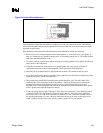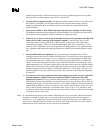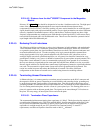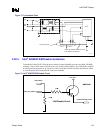
Intel
®
820E Chipset
R
116 Design Guide
2.22.4.2. Crystals and Oscillators
To minimize the effects of EMI, clock sources should not be placed near I/O ports or board edges.
Radiation from these devices may be coupled onto the I/O ports or out of the system chassis. Crystals
also should be kept away from the Ethernet magnetics module, to prevent communication interference.
The crystal’s retaining straps (if they exist) should be grounded to prevent possible radiation from the
crystal case, and the crystal should lie flat against the PC board to provide better coupling of the
electromagnetic fields to the board.
For noise-free and stable operation, place the crystal and associated discretes as close as possible to the
Intel
82562ET or Intel 82562EM component, keeping the trace length as short as possible. Do not route
any noisy signals in this area.
2.22.4.3. Intel
®
82562ET / Intel
®
82562EM Component Termination Resistors
The 120 Ω (1%) resistor used to terminate the differential transmit pairs (TDP/TDN) and the 100 Ω (1%)
receive differential pairs (RDP/RDN) should be placed as close as possible to the LAN connect
component (Intel
82562ET or Intel 82562EM component). The reason is that these resistors terminate the
entire impedance seen at the termination source (i.e., Intel
82562ET component), including the wire
impedance reflected through the transformer.
Figure 72. Intel
®
82562ET/82562EM Component Termination
IO_subsys_82562ET-82562EM_term
Intel®
82562ET
Magnetics
module
RJ45
Place termination resistors as
close as possible to Intel 82562ET.
LAN connect
interface
2.22.4.4. Critical Dimensions
As shown in Figure 73, two dimensions must be considered during layout: distance ‘B’ from the line
RJ45 connector to the magnetics module, and distance ‘A’ from the Intel
82562ET or Intel 82562EM
component to the magnetics module.


















